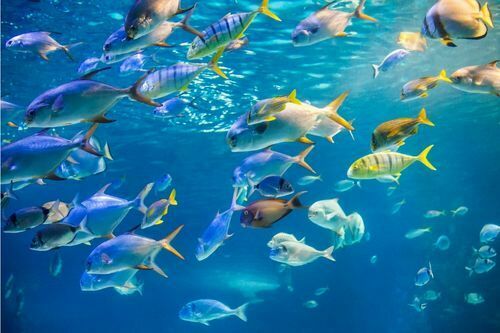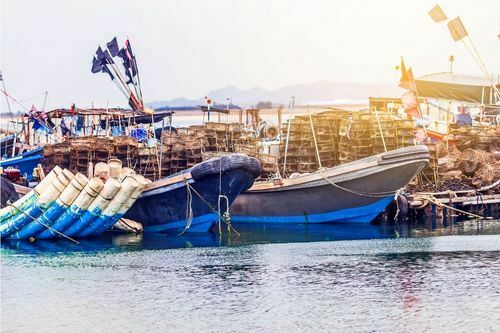Table of Contents
The Blue Revolution, also known as the Neel Kranti Mission, is a political movement in India that aims to achieve economic prosperity for the country and its fishers and farmers. It contributes to food and nutritional security by utilizing water resources to their full potential for sustainable fisheries development while considering bio-security and environmental concerns.
The Blue Revolution: An overview
The Blue Revolution (Nili Kranti) is a government initiative to expand the aquaculture industry. It began in China and now accounts for roughly two-thirds of total aquaculture manufacturing worldwide.
Recently, the aquaculture industry has been expanding rapidly, with India being one of the fastest-growing countries. The Neel Kranti Mission launched India’s Blue Revolution intending to achieve economic prosperity while considering sustainability, bio-security, and environmental concerns.
Nili Kranti in India

The Blue Revolution in India began during the 7th Five Year Plan (1985-1990), with the Central Government of India sponsoring the Fish Farmers Development Agency (FFDA). Later, at the time of the 8th Five Year Plan (1992-97). The Central Government of India launched the Intensive Marine Fisheries Program, and they eventually established fishing harbors in Vishakhapatnam, Kochi, Tuticorin, Porbandar, and Port Blair.
The Ministry of Agriculture and Farmers Welfare, in collaboration with the Departments of Animal Husbandry, Dairy, and Fisheries, planned to restructure this scheme and the other ongoing schemes under the ‘Blue Revolution.’ The National Fisheries Development Board was responsible for developing and managing fisheries under this scheme (NFDB).
The Blue Revolution Schemes include the following components:
- The hustle of the National Fisheries Development Board (NFDB)
- Improvements to the Fisheries Sector’s Database and Geographical Information System
- Inland Fisheries and Aquaculture Development
- National Fishermen’s Welfare Scheme
- Marine Fisheries Development, Infrastructure, and Post-Harvest Operations Monitoring, Control, and Surveillance (MCS), as well as other need-based Interventions
- Fisheries Sector Institutional Arrangement
The scheme’s objectives are as follows
1. To tap India’s total fish potential on land and sea and triple production by 2020.
2. Using new technologies and processes to transform the fisheries sector into a modern industry.
3. Doubling fishers’ income through increased productivity and improved post-harvest marketing infrastructure, including e-commerce, technologies, and world-class innovators.
4. Ensuring active participation of fishers and fish farmers in income generation.
5. Improving the nation’s nutritional and food security.
The salient feature of the blue revolution
We are providing appropriate linkages and convergence with the ‘Sagarmala Project’ of the Mahatma Gandhi National Rural Employment Guarantee Scheme (MANREGA), Ministry of Shipping, and National Rural Livelihoods Mission (NRLM), Rashtriya Krishi Vikas Yojana (RKVY), and others.
The Blue Revolution initiative focuses primarily on increasing the production and productivity of aquaculture and fisheries from both inland and marine sources.
They are promoting and encouraging economically disadvantaged groups, such as Scheduled Castes, Scheduled Tribes, Women, and their cooperatives, to take up fishing.
The Blue Revolution Scheme promoted the growth of entrepreneurship.
Components directly implemented by DOF:
Strengthening of Database & Geographical Information System (GIS) of the Fisheries Sector, Institutional Arrangement for the Fisheries Sector and
Monitoring, Control, and Surveillance (MCS) and other need-based
the DOF implemented interventions.
The three broad categories of financial support extended were:
(I) Individual beneficiaries/fishers, entrepreneurs, scheduled castes(SCs), Scheduled Tribes (STs) groups, women and their Cooperatives, SHGs, fish farmers, and miscellaneous fishermen bodies oriented schemes funded by DOF, GOI and
(ii) States/Union Territories, their agencies / organizations/ Corporations / Federations / Fishers Cooperatives / Fishers bodies/Boards/Panchayats and local urban bodies,
(iii) Central Government, Central Government institutes/Agencies, NFDB, ICAR institutes
Major blue revolution initiatives

The Blue Revolution initiatives of the Department of Fisheries and the NFDB have resulted in the development of the fisheries sector in terms of fish production, post-harvest infrastructure, marketing, and so on.
The economic condition of India through the augmentation of fisheries thus contributes to food and nutritional security. The Neel Kranti Mission sustainably utilized water resources for the development of fishing.
For developing pisciculture Under, Inland Fisheries & Aquaculture has been designed.
NFDB has directly extended some need-based activities mandated under the Blue Revolution scheme, with a particular emphasis on increasing productivity, livelihood generation, and developing better post-harvest and marketing infrastructure, as well as other need-based interventions.
Providing need-based quality training to fisheries department officials, extension functionaries, fishers, and fish farmers; conducting workshops, seminars, exhibitions, farmers’ meetings, and other events; and organizing various awareness and promotional programs.
Key takeaways
- The Indian Fisheries Sector currently produces 4.7 million tonnes of fish, including 1.6 million tonnes from freshwater aquaculture, against a quota of 60,000 tonnes (50 years ago)
- In making fish and fish products, India has achieved an average annual growth rate of 14.8%, compared to the global average of 7.5 percent.
- With a 6% to 10% growth rate over the previous five years, fisheries have become India’s largest agricultural export.
- With sales worth more than 47,000 crore rupees overseas, India has surpassed Japan as the world’s second-largest fish producer..
- The production of fisheries and aquaculture provides 1% and 5% of India’s GDP and Agricultural GDP, respectively.
Liked this blog? Read next: Everything you must know about the father of the green revolution!
FAQs
Q1. What exactly is India’s blue revolution?
Answer: Nili Kranti, or the Blue Revolution, refers to the period of rapid growth in the global aquaculture business from the mid-1960s until the present. The aquaculture business has been developing at a 9% annual rate, with India being one of the fastest-growing countries.
Q2. Who initiated India’s Blue Revolution?
Answer: Hiralal Chaudhuri and Dr. Arun Krishnsnan are known as the “Father of the Blue Revolution.” The Blue Revolution in India began during the 7th Five Year Plan (1985-1990), with the Central Government of India sponsoring the Fish Farmers Development Agency (FFDA).
Q3. What are the long-term consequences of the blue revolution?
Answer: The surge in the production of carnivorous fish (which accounts for all of the luxury fish raised) and shrimp has translated into higher demand for fishmeal, which must get supplied from wild fisheries, which is perhaps the most ubiquitous effect of the Blue Revolution. Fishmeal accounts for one-third of all fish catch worldwide. The surge in shrimp production, in particular, has introduced new fisheries to tropical areas where they were previously unknown.






